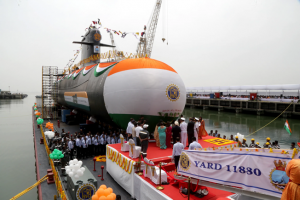WORLD GEOGRAPHY: MINERAL RESOURCES
1. WHY RISE IN NICKEL PRICE DUE TO RUSSIA-UKRAINE WAR CASTS A SHADOW ON THE SHIFT FROM FOSSIL FUELS TO EVS
THE CONTEXT: Between Western sanctions, a big bunch of export bans from Russia, and wildly fluctuating prices as a result of all the uncertainty, the Ukraine-Russia conflict has wreaked havoc on the global market for nickel — a key metal for industrial, military, construction, and transport goods.
THE EXPLANATION:
Nickel also happens to be essential raw material for rechargeable batteries, which are used in electric vehicles (EVs), sparking worries about the hoped-for move away from fossil fuels. Surging input prices, it is feared, could hinder ambitious EV-manufacturing plans.
- Russia accounts for about 11 per cent of the global supply of nickel ore, and 20 percent of the world’s top-grade or Class 1 nickel.
- Indonesia has about a third of the world’s nickel ores and is the biggest producer of the metal. In 2020, it produced 0.76 million tonnes of nickel, which is about a third of the global production followed by the Philippines (0.32 million tonnes) and Russia (0.28 million tonnes).
- But, a vast majority of Indonesia’s output comprises lower quality Class 2 nickel (NPI), which it exports to China for manufacturing stainless steel.
- In terms of Class 1 nickel, the McKinsey’s report cited earlier noted, Indonesia produced only 6.8 per cent compared to Russia’s 21.1 percent (in 2019).
- Part of the reason why EV manufacturers have been so dependent on Russia was that after 2012, when China started using NPI for stainless steel, the steel prices came down drastically. This incentivised producers like Indonesia to produce more and more of Class 2 nickel.
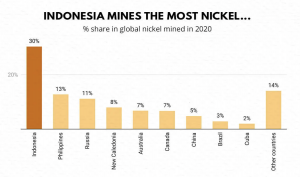
- According to projections by the intergovernmental organisation International Energy Agency (IEA), the “global EV stock across all transport modes (excluding two/three-wheelers) expands from over 11 million in 2020 to almost 145 million vehicles by 2030” — this represents an annual average growth rate of nearly 30 percent, with EVs estimated to account for about 7 percent of road vehicles by the start of the next decade.
- In this scenario, Indonesia has sensed the opportunity to channel some of its big nickel ores to the EV industry.
- While Indonesia is richer in a laterite called limonite — a good source for Class 2 nickel production — and does not have such abundant reserves of sulphur ores that are ideal for producing Class 1 nickel, it is devising workarounds to this issue.
THE ENVIRONMENT, ECOLOGY, AND CLIMATE CHANGE
2. INDIA’S FIRST PURE GREEN HYDROGEN PLANT COMMISSIONED IN ASSAM
THE CONTEXT: Recently, Oil India Limited (OIL) has commissioned India’s first Green Hydrogen Plant in Assam.
THE EXPLANATION:
- It is the first significant step towards Green Hydrogen Economy in India with the commissioning of India’s First 99.999% pure Green Hydrogen pilot plant, with an installed capacity of 10 kg per day at its Jorhat Pump Station in Assam.
- The plant is expected to increase its production of green hydrogen from 10kg from 30 kg per day in future.
- The plant also the first in India to use Anion Exchange Membrane Technology (AEM).
- In AEM technology the water is split into hydrogen and oxygen with an application of electric current, using a porous anion exchange membrane.
Green Hydrogen· It is a zero-carbon fuel made by electrolysis using renewable power from wind and solar to split water into hydrogen and oxygen. · This ‘Green hydrogen’ can be utilised for the generation of power from natural sources — wind or solar systems — and will be a major step forward in achieving the target of ‘net zero’ emission. · Less than 1% of hydrogen produced is green hydrogen. · It does not entail greenhouse gas emissions. It does not emit carbon dioxide when burned. |
OTHER TYPES OF HYDROGEN
- Black hydrogen is produced by use of fossil fuel.
- Pink hydrogen is produced through electrolysis but using energy from nuclear power sources.
- Brown hydrogen is produced using coal where the emissions are released to the air.
- Grey hydrogen is produced from natural gas where the associated emissions are released to the air.
- Blue hydrogen is produced from natural gas, where the emissions are captured using carbon capture and storage.
THE SCIENCE AND TECHNOLOGY
3. ISRO, IISC RESEARCHERS DEVELOP A WAY TO MAKE BRICKS FROM MARTIAN SOIL
THE CONTEXT: Researchers from the Indian Space Research Organisation (ISRO) and the Indian Institute of Science (IISc) have developed a way to make bricks from Martian soil with the help of bacteria and urea.
THE EXPLANATION: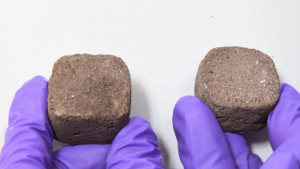
- These ‘space bricks’ can be used to construct building-like structures on Mars that could facilitate human settlement on the red planet.
- The team first made the slurry by mixing Martian soil with guar gum, a bacterium called Sporosarcina pasteurii, urea and nickel chloride (NiCl 2). “This slurry can be poured into moulds of any desired shape, and over a few days the bacteria convert the urea into crystals of calcium carbonate. These crystals, along with biopolymers secreted by the microbes, act as cement holding the soil particles together”.
- This method ensures that the bricks are less porous, which was a problem with other methods used to make Martian bricks. “The bacteria seep deep into the pore spaces, using their own proteins to bind the particles together, decreasing porosity and leading to stronger bricks”.
- Another challenge was the composition of Martian soil, which has a lot of iron that causes toxicity to organisms.
According to the sources, the team has also developed a lab-on-a-chip device that aims to measure bacterial activity in micro-gravity conditions. “The device is being developed keeping in mind our intention to perform experiments in micro-gravity conditions in the near future”.
With ISRO’s help, the team plans to send such devices into space, so that they can study the effect of low gravity on the bacterial growth.
4. LAUNCH OF SIXTH SCORPENE SUBMARINE ‘VAGSHEER’
THE CONTEXT: The sixth and last submarine of the Indian Navy’s Kalvari class submarines of Project 75 has been launched at the Kanhoji Angre Wet Basin of Mazagon Dock Limited (MDL).
THE EXPLANATION:
- The first of the Project – 75 submarines was commissioned into the Navy in December 2017 and presently four submarines of this Project are in commission in the Indian Navy.

- The fifth submarine is progressing with the Sea Trials and is likely to be delivered this year. The sixth submarine will now commence setting to work of various equipment and their harbour trials. The crew will thereafter sail the submarine for the rigorous Sea Acceptance Trials after which the submarine would be delivered to the Indian Navy by late 2023.
VALUE ADDITION:
- VAGSHEER: Named after the sandfish, a deadly deep water sea predator of the Indian Ocean, the first submarine ‘Vagsheer’ was commissioned in December 1974. It was decommissioned in April 1997.
- The Scorpene-class submarines are a class of diesel-electric attack submarines, featuring diesel propulsion and air-dependent propulsion.
- The submarine has four sub-types – CM-2000 conventional diesel-electric version, the AM-2000 air-independent propulsion derivative, the downsized CA-2000 coastal submarine and the enlarged S-BR for the Brazilian navy.
- The submarine can undertake several types of missions – anti-surface warfare, anti-submarine warfare, intelligence gathering, mine laying, and area surveillance.
- It has superior stealth features, including advanced acoustic absorption techniques, low radiated noise levels, a hydro-dynamically optimised shape, and the ability to launch crippling attacks using guided weapons. The features also give the submarine invulnerability, unmatched by most submarines.
PROJECT 75
- Project-75 (P-75) was conceptualised by former Prime Minister I K Gujral and faced many hurdles. The main objective of Project – 75 was to acquire 24 submarines. The project was approved by the Ministry of Defence in 1997.
History of Project – 75
- In 1998, India started negotiating with DCN. DCN is Direction des Constructions, a French defence contractor. India negotiated four Scorpene class submarines with DCN. Of these two were to be built in Mazagon Dock Limited.
Project – 75 upgraded after Kargil War
- After Kargil war in 1999, the Indian Government approved a 30-year submarine plan. The Project – 75 was brought under this new plan. Under the new plan, two parallel production lines of the submarines were called for. One was under the already running Project – 75 and the other was under Project – 75I (Project – 75 India).
Construction of Six Submarines
- In 2005, under Project – 75, India signed a transfer of technology contract with the French. Under this contract six submarines were to be constructed at the Mazagon Dock Limited. These submarines were to be delivered by 2012. The Scorpene class submarine was selected because of its capability to fire anti-ship missiles and air-independent propulsion.
Delivery of the submarines:
- INS Kalvari was the first submarine delivered under Project – 75. It was delivered in 2015.
- INS Khanderi was the second submarine. It was commissioned in 2019.
- INS Karanj was the third submarine. It was commissioned in March 2021.
- INS Vela was the fourth submarine. It was commissioned in November 2021.
- INS Vagir is the fifth submarine.
- INS Vasgheer is the sixth submarine.
5. INDIA & FINLAND DISCUSS POSSIBLE AREAS OF COOPERATION IN QUANTUM COMPUTING FOR THE VIRTUAL CENTRE OF EXCELLENCE (COE)
THE CONTEXT: Delegates from India and Finland discussed possible areas of co-operation in quantum computing and a road map for the collaborative virtual Centre of Excellence (CoE) that has been planned to be set up.
THE EXPLANATION:
- According to the DST, “the two countries are trying to get academic and industrial partners which can help develop quantum science and technology for the betterment of humankind in particular and the planet in general. India and Finland committed towards global excellence in this field to achieve the best possible technologies in the shortest possible time.
VALUE ADDITION:
What is Quantum Computing?
Quantum Computing is the area of study focused on creating computer technology based on the principles of quantum theory which describes the nature and behaviour of matter and energy on the quantum (atomic and subatomic) level.
Why Quantum Computing?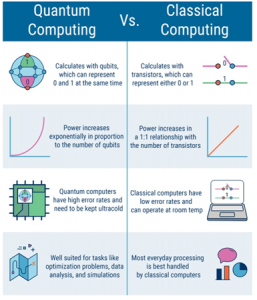
Development of a quantum computer would mark a major leap forward in computing capability far greater than that of a modern-day supercomputer as the quantum computer has the enormous processing power and it can perform tasks using all possible permutations simultaneously = the performance gains are enormous.
For instance, to sort a billion numbers, a quantum computer would only need 3.5 million fewer steps than a conventional machine.
The following are the major advantages of Quantum Computers.
- Faster: It can perform any task faster as compared to a classical computer. Because atoms move faster in a quantum computer than a classical computer.
- Accurate: It’s highest level accuracy makes it suitable for national security and big data handling.
- Energy-efficient: It wastes less energy while working = it is cost-effective after implementation.
THE GOVERNMENT SCHEMES AND INITIATIVES IN NEWS
6. INDIA POST PAYMENTS BANK LAUNCHES ‘FINCLUVATION’
THE CONTEXT: On the occasion of the 75th anniversary of Indian Independence & ongoing Azadi ka Amrit Mahotasav, India Post Payments Bank (IPPB), a 100% government owned entity under Department of Posts (DoP) announced the launch of Fincluvation– a joint initiative to collaborate with Fintech Startup community to co-create and innovate solutions for financial inclusion.
THE EXPLANATION:
- “Fincluvation will be a permanent platform of IPPB to co-create inclusive financial solutions with participating start-ups. It invites startups to Participate, Ideate, Develop and Market intuitive and tailored products and services that can be taken to the customers. Startups are encouraged to develop solutions aligned with any of the following tracks-
- Creditization – Develop Innovative & Inclusive credit products aligned with the use cases of target customers and take them to their doorsteps through Postal network.
- Digitization – Bring convenience through convergence of traditional services with Digital Payment Technologies such as making the traditional Money Order service as Interoperable Banking service.
- Any Market-led solutions that can help solve any other problem relevant to IPPB and/or DoP in serving the target customers.
- Intersection of technology with financial services coupled with traditional distribution networks is opening up new set of business opportunities. Conventional model of technology procurement led product creation by banks often lacks value in user experience leaving huge gap between customer expectations and service delivery. Traditional technology firms fail to meet these expectations with a deficit of ownership in product creation.
- Fincluvation mentors will work closely with the startups to tweak products to the customer needs and align the go-to-market strategies with operating models of IPPB and DoP.
About India Post Payments Bank
- India Post Payments Bank (IPPB) has been established under the Department of Posts, Ministry of Communication with 100% equity owned by Government of India.
- The bank has been set up with the vision to build the most accessible, affordable and trusted bank for the common man in India. The fundamental mandate of IPPB is to remove barriers for the unbanked and under-banked and reach the last mile leveraging a network comprising 160,000 post offices (145,000 in rural areas) and 400,000 postal employees. IPPB’s reach and its operating model is built on the key pillars of India Stack – enabling Paperless, Cashless and Presence-less banking in a simple and secure manner at the customers’ doorstep, through a CBS-integrated smartphone and biometric device.
- Leveraging frugal innovation and with a high focus on ease of banking for the masses, IPPB delivers simple and affordable banking solutions through intuitive interfaces available in 13 languages. IPPB is committed to provide a fillip to a less cash economy and contribute to the vision of Digital India.
THE DATA SHEET
DEFENCE MANUFACTURING
- The 65.5 percentage of the capital acquisition budget of the financial year 2021-22, utilised for making procurements from domestic sources, according to the Defence Ministry. The Ministry added that they had earmarked 64% of the capital acquisition budget for domestic industry and were able to ‘overachieve’ this target.
- In May 2020, the government announced increasing the foreign direct investments limit from 49% to 74% under the automatic route in the defence sector.
CLIMATE EMERGENCY: A GRAPHICAL ANALYSIS
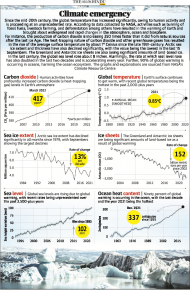
THE PRELIMS PRACTICE QUESTIONS
QUESTION OF THE DAY
Q. Which of the following pairs is/are correctly matched?
-
- Kanpur – Nana Saheb
- Lucknow – Khan Bahadur Khan
- Bareilly – Begum Hazrat Mahal
- Bihar – Kunwar Singh
Select the correct answer using the code given below:
a) 1 and 2 only
b) 2 and 3 only
c) 3 and 4 only
d) 1 and 4 only
ANSWER FOR 20TH APRIL 2022
Answer: B
Explanation:
- The Office of the High Commissioner for Human Rights (UN Human Rights) is the leading UN entity on human rights.
- It represent the world’s commitment to the promotion and protection of the full range of human rights and freedoms set out in the Universal Declaration of Human Rights.
- UN General Assembly established Office of the High Commissioner for Human Rights in December 1993.
- This was just a few months after the World Conference on Human Rights adopted the Vienna Declaration and Plan of Action.
- The High Commissioner for Human Rights is the principal human rights official of the United Nations.
- The United Nations High Commissioner for Human Rights is accountable to the Secretary-General and is responsible for all the activities of OHCHR, as well as for its administration.
- United Nations High Commissioner for Human Rights is appointed by the Secretary General of the United Nations and approved by the General Assembly, with due regard to geographical rotation for a fixed term of four years with a possibility of on renewal for another fixed term of four years.

